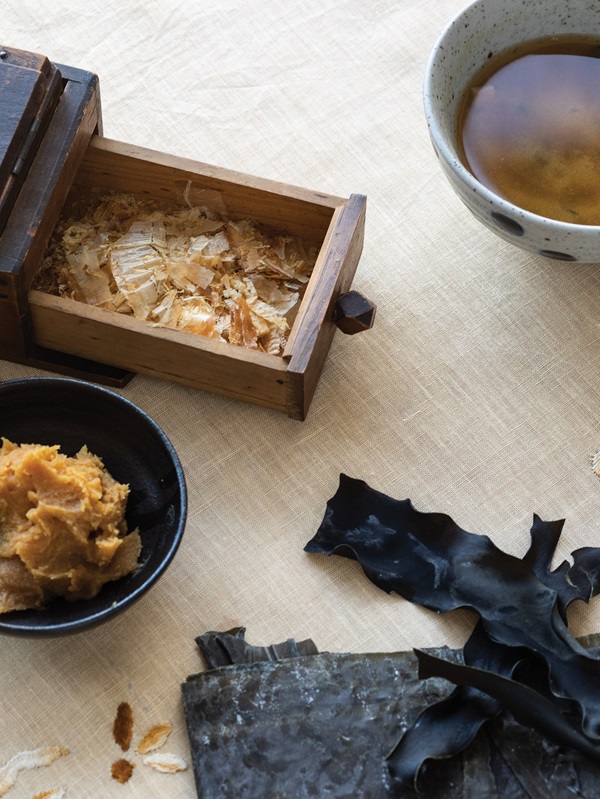Seaweed Season
Find A Healthy Balance With Early Summer Seaweed
This column explores the intersection of food and herbs as medicine. The title Medicine Meal comes from the Japanese Yakuzen culture, which is about creating delicious, healing meals using traditional Chinese medicine herbs and principles.
According to traditional Chinese medicine (TCM), Summer has two distinct seasons—early and late summer. We are currently in the early summer months, from May through July, when the days are long and energy is at its peak within and around us. Simply stepping out into a garden or visiting a farmers’ market allows us to witness the abundance of food, flowers, animals, and humans buzzing about.
HEALING FOODS FOR EARLY SUMMER
Every season is represented by natural phenomena, and early summer is associated with the heart. Heart energy imbalances include insomnia, anxiety, poor memory and focus, heart palpitations, and poor circulation. Seasonal healing foods and herbs will benefit the heart (think rose, hawthorn, chamomile, and motherwort) or be cool, invigorating, and Yin in nature.
What is Yin? Yin is a healing property that balances the mind, benefits sleep, and replenishes youthfulness and profound hydration. Yin foods include seaweeds, mushrooms, broths and soups, blueberries, goji berries, mulberries, and marshmallow root and leaf. Seaweed, specifically, is a Yin-rich food and medicine harvested on the Sonoma Coast during the early summer months.
Early summer foods lend themselves to a lighter, simpler diet that calms the heart and focuses the mind. Sautéing, steaming, light pickling, and a moderate amount of raw food allows us to minimize our efforts and oven use. According to TCM, the tastes of early summer are bitter and spicy, and cool the body. Try kale, chard, collards, mustard, arugula, dill, basil, scallions, sprouts, garlic, ginger, sunflower seeds, almonds, and pistachios, and focus on light, cooling foods like cucumbers, tomatoes, mushrooms, celery, lettuce, raspberries, strawberries, melons, amaranth, quinoa, red lentils and whole grain wheat, rice and oats. Conversely, stimulating foods like coffee, sugar, and alcohol, rich foods, and excessive iced drinks can lead to anxiety and illness.
Cooking with seaweeds may sound intimidating, but you have likely tried wakame (the one floating in miso soup) or the nori sheets that wrap sushi rolls. Home cooks can add kombu to dishes that cook over time, like beans and soup, or sprinkle powdered nori on avocado toast for added nutrition, protein, and Yin energy.
Here are a few of my favorite, easy ways to add more nutrient-rich seaweed to your diet.
Sonoma Coast Gomashio
MAKES 1 1/2 CUP
Gomashio (sesame salt) is a common Japanese condiment used to season everything from rice and grains to salads. This blend combines the classic mixture of sesame seed, salt, and seaweed. Make it at home, buy it at Farmacopia Santa Rosa, or try it on the delicious furikake fingerling potatoes at Belfare in Petaluma.
INGREDIENTS:
1 cup sesame seeds, white or black
1 oz wakame seaweed, dried
1 oz kombu, dried
1/8 cup sea salt
Make the seaweed powder: Spread 1 ounce each of dried kombu and wakame on a sheet pan and bake at 350° F. Cook for 15 minutes until it crumbles and breaks when pressed. Cool and grind seaweed using a blender. Remove thick stalks and chunks that do not powder easily. Store powder in an airtight container until ready to use.
Make the gomashio: Toast the sesame seeds in a heavy or cast-iron skillet, constantly stirring with a wooden spoon, until fragrant and just starting to pop for a few minutes. Do not overcook the sesame seeds. Remove from heat and allow to cool slightly. Combine the sesame seeds and salt in a blender or suribachi mortor and pestle, and lightly grind to a powder. Mix in ¼ cup of seaweed powder. Store in an airtight container in a cool, dark cupboard.
Kombu Shiitake Dashi
MAKES 4 CUPS (960 ml)
Dashi is a Japanese stock base for many recipes, including miso soup. Bonito flakes can be found at Asiana Market in Cotati.
INGREDIENTS:
1 piece of kombu seaweed, about 2 x 5 in (5 x 12 cm)
3 dried shiitake mushrooms
3 cups (20g) bonito flakes
In a medium pot, combine kombu, shiitake mushrooms, and 5 cups (1.2L) of filtered water. Warm over low heat until bubbles form around the kombu. Remove the kombu right before the water comes to a boil. Once the water comes to a boil, remove the pot from the heat. Add the bonito flakes and infuse for 2 minutes. Using a cheesecloth-lined colander or fine-mesh sieve, strain the dashi. Allow the mixture to filter slowly, and do not press out the bonito flakes, or it will make the dashi cloudy. Use immediately or refrigerate for up to 4 days.
Wakame Miso Soup
SERVES 4
Miso soup is a Yin nourishing meal with ingredients from the land and sea. Make your own or try my favorite restaurants for miso soup: Hana Sushi in Rohnert Park and Sake 107 in Petaluma.
INGREDIENTS:
2 Tbsp dried wakame seaweed
4 cups (960 ml) Kombu Shiitake Dashi
(see recipe on this page)
¼ cup red or yellow miso paste
4 oz (115 g) tofu, cut into small cubes
Soy sauce, for seasoning
2 green onions, thinly sliced
To prepare the wakame, rehydrate in 2 cups (480 ml) of water for 15 minutes. Drain and cut into ½ in (12mm) pieces. In a medium pot, bring the dashi to a boil over medium heat then reduce heat to low and simmer while you prepare the miso.
In a small bowl, dissolve the miso in ½ cup (120 ml) of warm dashi. Add this back to the soup with the tofu and prepared wakame. Turn off the heat once the tofu is heated through, about 1 minute. Taste for seasoning and add some soy sauce if needed. Divide the soup among 4 bowls, sprinkle with green onions, and serve immediately.
Recipes excerpted from Asian American Herbalism: Traditional and Modern Healing Practices for Everyday Wellness by Erin Masako Wilkins. Published by Princeton Architectural Press, owned by Chronicle Books. Copyright © 2023 by Erin Masako Wilkins.
Erin Masako Wilkins is an Asian American herbalist, Japanese acupuncturist, and the author of Asian American Herbalism: Traditional and Modern Healing Practices for Everyday Wellness. She owns the online tea shop Herb Folk, teaches virtual and in-person workshops, and is faculty at the California School of Herbal Studies and Land of Verse.
DISCLAIMER: Be sure to identify plants properly when foraging for wild plants. Exercise caution and seek guidance from experienced foragers. Consult a qualified healthcare professional before taking new herbal supplements or changing your diet, especially if you are pregnant, nursing, immunocompromised, or on medication. As always, seek outside help if something doesn’t feel right for you.




